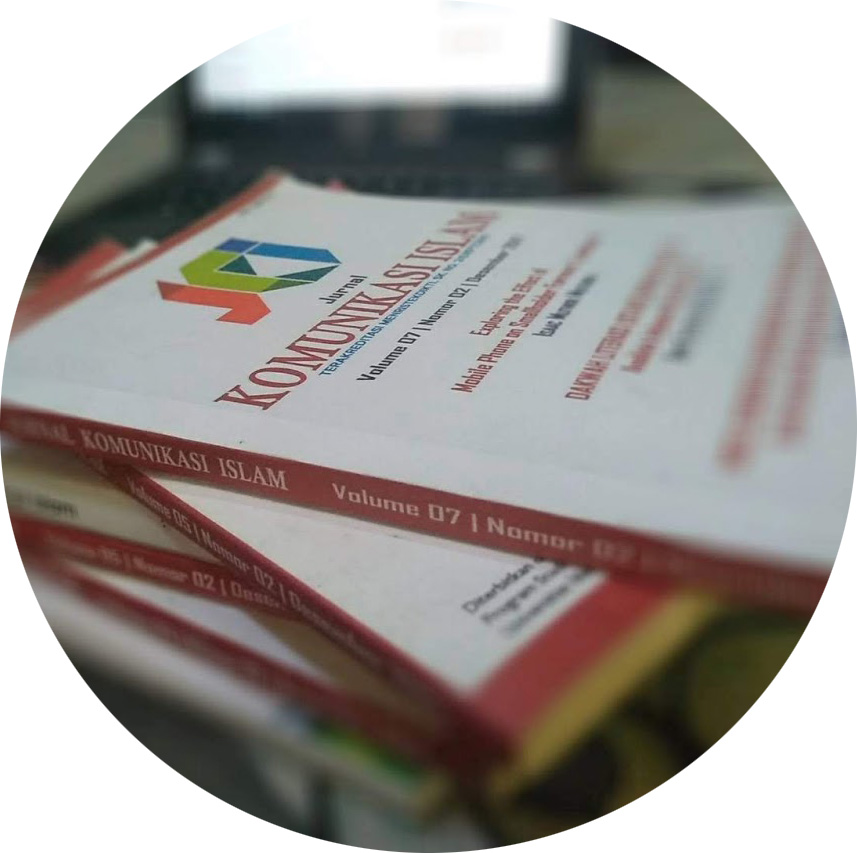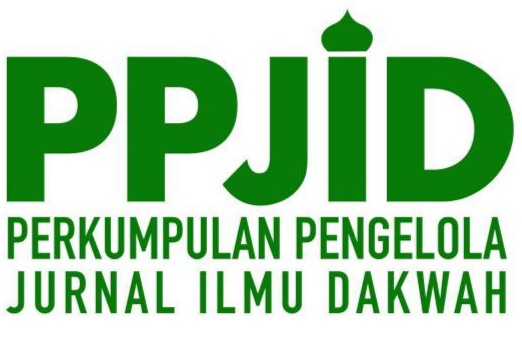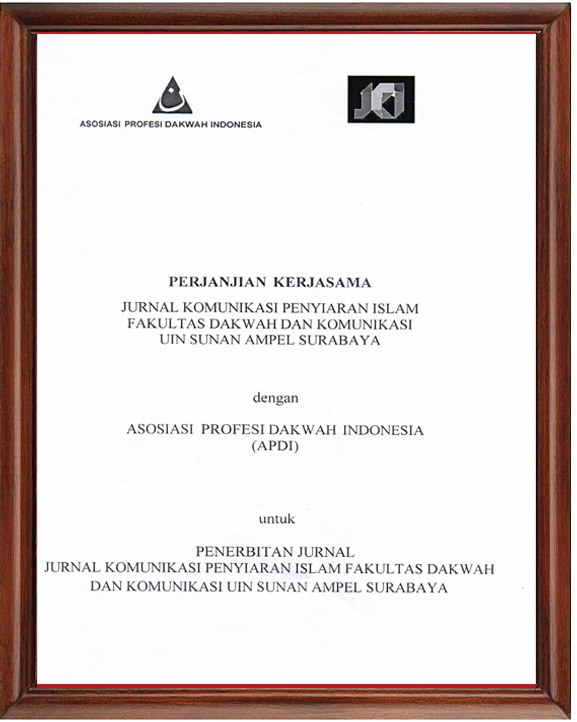Uses and Effects of Religious Programs among Yemeni Audiences
DOI:
https://doi.org/10.15642/jki.2013.3.2.179-225Abstract
Abstract: The study aims to contribute to the current under–standing of how audiences make use of religious programs broadcasted in both religious satellite channels (RSCs) and Arabic satellite channels. 210 respondents were surveyed to address the nature of exposure to RSCs and religious pro–grams, motives, and attitudes toward them. Utilizing uses and effect approach and Hall’s encoding and decoding model of media discourses, this study confirms a high expo–sure to RSCs among adult television viewers in Yemen. Of religious contents, Islamic lectures particularly represent the most watched program by respondents. It also states that emotional effects represent the prominent effects of religious programs uses followed by normative, and limited beha–vioral effects.
Keywords: religious programs, uses and effects approach, Hall's encoding/decoding model, Yemeni audience.
Downloads
References
Abdulhaleem, M. 1992, ‘Al-e’elam al-eslami: al-osool, wa al-kawaed wa al-ahadaf’ [Islamic communication: origins, rules, and goals], paper presented at Al-Azhar University Symposium on Islamic communication between challenges of the reality and future ambitions, Cairo, May.
Abdulhameed, M. 1992, ‘Al-bahth al-elmi fi majal al-e’elam al-eslami: eshkaliato wa dawroh al-wadeefi’ [Scientific research in the field of Islamic communication: problematic and functional role], paper presented at Al-Azhar University Symposium on Islamic communication between challenges of the reality and future ambitions, Cairo, May.
Abdulmuti, S. R. 1997 ‘Estikdam al-e’elam al-deni wa esba’ato fi misr; derasa maidaneyah ala a’ayenah min gamaher almogtama’a al-refi’ [Religious media use and gratifications: field study on a sample of audiences of the rural society], Journal of Mass Communication, 7, pp. 7-77.
Abelman, R. 1987, ‘Religious television uses and gratifications’, Journal of Broadcasting & Electronic Media, vol. 29, 2, pp 293-307.
Agwa, A. 1992, ‘Al-e’elam al-eslami fi al-karn al-wahed wa al-eshreene’ [Islamic communication in the twenty first Century], paper presented at Al-Azhar University Symposium on Islamic com–munication between challenges of the reality and future ambitions, Cairo, May.
Al-Abdulkareem, M. 2009, Dersah makasediah moogazah an al-e’elam alfadae’e “aleslami”. [Brief and purposively study about the "Islamic" satellite media]. Accessed 20 January 2011 from ?http://islamtoday.net/bohooth/artshow-86-111059.htm?.
Alali, F. 2007, ‘Al fadaeyat almahaliyah wa tade’em alkiyam fi mogtama’a alemarat: derasah maidaniyah’ [Local satellite chan–nels and reinforcing values in UAE society: filed study], paper presented at the College of Mass Communication Conference on Media, social and cultural construction for Arabic citizen, Cairo, May.
Alali, F. 2008, Dawr alkaem biletisal fi tabani albaramig altelevisyone lemaso’oliyataha tegah almogtama’a fi dalat alemarat: derasah maidaniyah. [Role of communicator in the adoption of tele–vision talk shows of its responsibility towards society in the UAE: A Field Study], paper presented at the College of Mass Communication Conference on Media between freedom and responsibility, Cairo, July.
Aldogain, B. E. 2008, ‘Estikdamat Almara’a alsaudia lilbaramig alegtimaeya’a fi alkanawat alfadaeyah alarabiya- derasah wasfe–yah maidaneyah al ayenah min alnesa’a fi madeenat alreyad’ [Saudi woman uses of social programs in Arabic satellite channels- descriptive and field study on a sample of women in Riyadh], unpublished thesis, Al-Imam Muhammad Ibn Saud Islamic University. Accessed 20 April 2011 from ?http://libback.uqu.edu.sa/hipres/ABS/ind10826.pdf?.
Alkhathab, Z. 2011, ‘alkanawat alfadae wa ba’ath alkeyam alegtimaeyah- derasah wasfiyah motabakah ala talebat almarhalh althanawiah bemohafadat alnoaireyah be elmantikah alsharkeya min almamlakah alarabiyah alsudiya’ [Satellite channels and some social values- a descriptive study, applied to high school students in Al-Noireyah governorate- the eastern region of Saudi Arabia], unpublished thesis, King Saud University. Accessed 20 January 2011 from ?http://socio.montadarabi.com/t573-topi?
Alsaedi, F. H. H. 2008, ‘Isham ba’ath albaramig aldeeniyah fi kanat al-majd alfdae’eyah fi tahkeek ahdaf altarbeyah al-islamiyah’ [Contribution of some religious programs in Al-majd satellite channel for fulfillment of Islamic educational objectives], unpublished thesis, Om el Kora University. Accessed 20 April 2011 from ?http://libback.uqu.edu.sa/hipres/FUTXT/806.pdf?
Al-Shami, A. M. (2009) ‘ta’arod alshabab algmei alyamani lilmosalsalat almodablagh wa alathar almohtamalh’ [The Yemeni university students’ exposure to soap opera and its potential effects], Jordan Journal for Social Sciences, vol.6, no.2, pp. 108-136.
Alsherif, M. A. 2006, ‘al-barameg al-deeneya fi al-kanawat al-fadae’e: derasah tahleeliyah’ [Religious programs in Arabic satellite channels: an analytical study], unpublished thesis, Al-Azhar University. Accessed 15 September 2011: ?http://www.siironline.org/alabwab/solta4(17)/158.htm
Asran, S. 1994, ‘Estekdamat waeshba’at al-televisyone lada a’emat al-masajed fi mohafathat al-kahera; derasa maidaniya’ [Television uses and gratifications among mosques’ Imams in Cairo governorate; a field study], Journal of Media Researches, Al Azhar University, October issue, pp. 265-305.
Awan, F. 2007, ‘Young people, identity and the media: a Study of conceptions of self-identity among youth in Southern England’, unpublished thesis, University of Bournemouth.
Bahonar, N. (nd) Television religious program and audience reception: a comparative study on Iranian TV Islamic programs and electronic church. Accessed 25 January 2011 from ?http://www.portalcomunicacion.com/bcn2002/n_eng/programme/prog_ind/papers/b/pdf/d_b014_bahon.pdf?
Black, J. and Bryant, J. 1995, Introduction to Communication: Understanding the Past, Experience the Present, Marvel at The Future, 4th edn, Brown & Benchmark Publishers, Ubuque IA.
Etefa, A. 2005, Arabic satellite channels in the US: uses & gratifications, paper presented at the International Communication Association conference on Communication: Questioning the Dialogue, NY, May.
Ghareeb, M. 1995, ‘Dawr albaramig aldeneyah bi elkanawat alfadeyah al arabia fi althatkeef aldeeni lada tolab aljamea’at: derash maidaniyah’ [Role of the religious programs in religious education of university students- field study], Egyptian Journal of Public Opinion, 6(2), pp. 395-448.
Hall, S. 1980, ‘Encoding/decoding’, in Hall, S., Hobson, D., Lowe, A. and Willis, P. (Eds.) Culture, Media, Language, Hutchinson, London.
Ibrahim, S.S. 2007, ‘Dawr Al kanawat alfadaeyah al islamiyah fi imdad aljumhore be althakafa aldeeniyah’ [Role of Islamic satellite channels in providing audience with religious culture], paper presented at the College of Mass Communication Conference on Media, social and cultural construction for Arabic citizen, Cairo, May.
Iraqi, S. 2006, ‘Asaleeb tatweer alketab aldeeni fi alkanawat afadaeyah alarabiah’ [Methods of developing the religious discourse in the Arab satellite channels], paper presented at the College of Mass Communication Conference on Media and modernization of Arabic societies, Cairo, May.
Katz, E., Blumler, J. and Gurevitch, M. 1974, ‘Utilization of mass communication by the individual’, In J. Blumler and E. Katz (Eds.), The uses of mass communication: current perspectives on gratifications research, Sage, CA.
Katz, E. and Liebes, T. 2010, ‘Reading television: television as text and viewers as decoders’ In Thussu, D (ed.), International Communication, Routledge. NY.
Marghalania, K., Palmgreenb, P. and Boyd, A. D. 1998, ‘The utilization of direct satellite broadcasting (DBS) in Saudi Arabia’, Journal of Broadcasting & Electronic Media, 42(3), pp. 297 – 314.
Mesbah, H. M. 1991, ‘Uses and gratifications of television viewing among Egyptian adults’, unpublished thesis, American University in Cairo.
Mohamed, A. A. 2007, ‘Dawr al kanawat alfadaeyah al islamiyah fi imdad alshabab be ilma’alomat alhayateyah’ [Role of Islamic satellite channels in providing youth with information on the actual reality issues], paper presented at the College of Mass Communication Conference on Media, Social and Cultural Construction for Arabic Citizen, May.
Mubarak, A.T.E. 2010, ‘Kathaya almohamasheen fi altelvisyone almesri: derasah maidaniya aljomhoore’ [Issues of the poor and marginalized people in the Egyptian television: a field study to the audience], paper presented at presented at the College of Mass Communication Conference on Media and issues of poverty and the marginalized people: the reality and challenges, July. Accessed 20 April 2011 from Online. Available HTTP: ?http://masscomm.cu.edu.eg?
Najwa, A. and et al. (n.d) ‘Ae’elam wa almara’a fi alreef wa alhadar; derasah tatbekeyah al misr wa albahreen’ [Media and woman in urban and rural area; implementing study in Egypt and Bahrain]. Accessed 20 April 2011 from ?http://www.scw.gov.bh/media/pdf/woman-media-study.pdf?
Poonam, P. 1992, Rereading Stuart Hall’s Encoding/Decoding Model. Communication Theory, vol. 2, 3, pp. 221-233.
Rubin, A. M. 1983, ‘Television uses and gratifications: The interactions of viewing patterns and motivations’, Journal of Broadcasting, vol. 27, 1,pp. 37-51.
Rubin, A. M. 1986, ‘Uses, gratifications, and media effect research’ in J. Bryant and D. Zillmann (Eds.), Perspectives on Media Effects, first ed., pp. 281-301. Hillsdale, Lawrence Erlbaum Associates, Publishers, New Jersey.
Salamah, M. A. 2010, ‘Al-fadaeyat al-islamiah fi asr al-awlamah’ [Religious satellite channels in globalization era], unpublished thesis, American University in Columbus. Accessed 20 March 2011 from ?http://www.magmj.com/print.jsp?id=3507?
Salwen, M. and Stacks, D.W. (1996) An integrated approach to communication theory and research, New Jersey: Lawrence Erlbaum Associates Publishers.
Scherer, C. 2010, ‘Uses & gratifications in college students’ media use: a test of media complementarity theory’, unpublished thesis, University of Dayton. Accessed 15 September 2010 from ?http://etd.ohiolink.edu/send-pdf.cgi/Scherer%20Carrie.pdf?dayton1271699466? .
Schedler, P, E., Glastra, F., and Kats, B. 1998, ‘Public Information and Field Theory’, Political Communication, vol. 15, pp. 445-461.
Stanley, Harold W., and Richard G. N. 1998, Vital Statistics on American Politics, 1997-1998, Congressional Quarterly Press, Washington, D.C.
Ritzer, G. and Ryan, M. J. 2011, The Concise Encyclopedia of Sociology, Wiley-Blackwell. Accessed 14 September 2011 from ?http://books.google.com/books?id?
Unite Nation Development Program. 2011, ‘UNDP Yemen focus areas, poverty reduction’. Accessed 30 April 2013 from ?http://www.undp.org.ye/poverty.php?
Webster, J. G. 2005, ‘Beneath the Veneer of Fragmentation: Television Audience Polarization in a Multichannel World’, Journal of Communication, vol. 55, no.2, pp. 366-382. Accessed 15 September 2010 ?http://web4.soc.northwestern.edu/programs/phd_media_technology_society/publications/Webster_2005.pdf?.
Williams, K. 2003, Understanding Media Theory, 1st edn, Arnold, London.
Wren-Lewis, J. 1983, ‘The encoding/decoding model: criticisms and redevelopments for research on decoding’, in Media, Culture and Society, 5, pp. 179-197. Accessed from ?http://mcs.sagepub.com/content/5/2/179.extract?
Yasine, M. 2010, ‘Al Mohamashone bain alazl waalagz: derasa maidaneya fi alawe’e altelevisioni almodrak’ [Marginalize people between isolation and disability: field study on perceived television reality], paper presented at the College of Mass Communication Conference on Media and issues of the Poverty and Marginalized People: the Reality and Challenges, July. Accessed 20 April 2011 from ?http://masscomm.cu.edu.eg?.
Zebra, A. 2003, ‘Perceived Motives for clicking on multimedia features on news web sites: an exploratory study’, unpublished thesis, University of Florida. Accessed 14 September 2011 from ?http://etd.fcla.edu/UF/UFE0000834/zerba_a.pdf. 9?.













